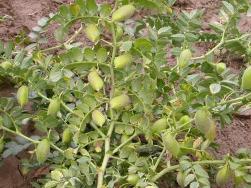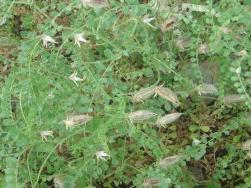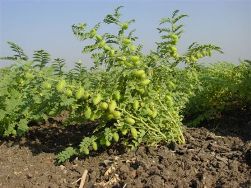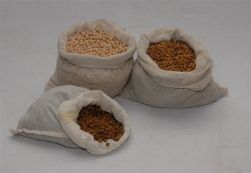Chickpea genetic resources
Contact person for Chickpea: Hari D Upadhyaya, ICRISAT, India
Contributors to this page: ICRISAT, Patancheru, India (Hari D Upadhyaya, Shivali Sharma, Cholenahalli L Laxmipathi Gowda, Dintyala Sastry, Sube Singh); NBPGR, New Delhi, India (Shyam Sharma); ICARDA, Aleppo, Syria (Ahmed Amri, Kenneth Street, Natalya Rukhkyan), SARC-RIPP, Piestany, Slovak Republic (Gabriela Antalikova); Institute of Plant Genetic Resources ‘K.Malkov’, Sadovo, Bulgaria (Siyka Stoyanova); Department of Primary Industries, Victoria, Australia (Bob Redden); IPK, Gatersleben, Germany (Andreas Börner).
External reviewer: Shyam Yadav (Momase Regional Research Centre, Papua New Guinea).
Compilation of best practices
|
A chickpea plant (photo: ICRISAT) |
|
Diversity of chickpea seeds (photo: ICARDA)
|
Compilation of information on current practices for genebank management of chickpea was lead by ICRISAT, Patancheru, India in collaboration with Bioversity International. Current genebank practices and accumulated experience were gathered from six other genebanks/institutions holding global/regional/national collections of chickpea germplasm, including ICARDA, Aleppo, Syria; NBPGR, New Delhi, India; SARC-RIPP, Piestany, Slovak Republic; Institute of Plant Genetic Resources ‘K.Malkov’, Sadovo, Bulgaria; Department of Primary Industries, Victoria, Australia; and IPK, Gatersleben, Germany. The majority of the centres were following standard practices in managing their collections. Data from these centres were reviewed and the best and adaptable practices were identified and compiled here. Information was edited into a uniform format and uploaded onto this website, complemented with relevant photos and revised and validated by the crop experts.
Importance and origin
The genus Cicer comprises one cultivated species, the chickpea (Cicer arietinum L.) and 42 wild species. Chickpea probably originated from South East Turkey. Four centres of diversity were identified in the Mediterranean, Central Asia, the Near East and India, as well as a secondary centre of origin in Ethiopia (Vavilov, 1951). Chickpea spread with human migration toward the West and South via the Silk Route (Singh et al, 1997). Proof of chickpea cultivation dates back as far as the early Bronze Age in Jericho (Hopf, 1969). Chickpea has a relatively minor importance in the world market but it is extremely important for local trade in numerous tropical and subtropical regions. It is grown and consumed in large quantities from South East Asia to India and in the Middle East and Mediterranean countries. It ranks second in area and third in production among the pulses worldwide.
Most production and consumption of chickpea takes place in developing countries. It is one of the dry edible legumes with best nutritional composition. It does not contain any specific major anti-nutritional or toxic factors often present in other legumes. Chickpea seeds contain an average of 23% proteins and the crop meets up to 80% of the nitrogen requirements from symbiotic nitrogen fixation.
Types
Chickpea is a diploid and predominantly self-pollinated legume, but cross-pollination by insects sometimes occurs (Purseglove, 1968). It belongs to the Fabaceae family. Thirty-four of the chickpea wild relatives are perennials and the other nine (including the cultivated species) are annuals. Three genepools have been proposed for grouping Cicer species: the primary genepool (GP1) includes the cultivated species C. arietinum and two wild annual species C. echinospermum P.H. Davis and C. reticulatum Ladiz., the putative wild progenitor (Ladizinsky and Adler, 1976). Some authors also group the perennial wild Cicer species C. anatolicum Alef., with the primary genepool species (Choumane and Baum, 2000). The secondary genepool (GP2), the next closest group, consists of three annual wild Cicer species, C. judaicum Boiss. and C. pinnatifidum Jaub. & Spach (Tayyar and Waines, 1996). The tertiary genepool (GP3), the most distantly related group, includes three annual wild Cicer species, C. yamashitae Kitam., C. chorassanicum (Bunge) Popov and C. cuneatum Hochst. ex A. Rich., and 34 wild perennial Cicer species (Ahmad et al, 2005).
 |
 |
 |
|
Showing chickpea diversity (from left to right): Cicer arietinum, Cicer microphyllum and Cicer microphyllum |
||
Based on seed size and shape, two main kinds of chickpea are recognized: The Desi types closer to the putative progenitor (C. reticulatum) found predominantly in India and Ethiopia, which have small, angular, coloured seeds and a rough coat. They have a bushy growth habit and blue-violet flowers. The Kabuli types, predominantly grown in the Mediterranean region, have large, beige-coloured and owl-head shaped seeds with a smoother coat. Their plants have a more erect grown habit and white flowers.
|
|
| Chickpea in bags as it is sold in markets (photo: ICRISAT) |
Utilization
Chickpea is a cool-season food legume grown mainly by small farmers in many parts of the world. It is an important source of protein in the diets of the poor, and is particularly important in vegetarian diets. It is also being used increasingly as a substitute for animal protein. It is cultivated primarily for its seeds rich in proteins. The plant also plays an important role in farming systems, due to its efficient symbiotic nitrogen fixation properties.
References and further reading
Ahmad F, Gaur PM, Croser J. 2005. Chickpea (Cicer arietinum L.). In: Singh RJ, Jauhar PP, editors. Genetic Resources, chromosome engineering, and crop improvement - Grain Legumes Vol. 1. CRC Press, USA. pp 187-217.
Choumane W, Baum M. 2000. The use of RAPD markers for characterization of annual species of the genus Cicer. Annals of Agricultural Science (Cairo) 2:809–820.
Global Crop Diversity Trust. 2008. Global strategy for the ex situ conservation of chickpea (Cicer L.) [online]. Available from:
http://www.croptrust.org/documents/web/CicerStrategy_FINAL_2Dec08.pdf. Date accessed: 25 May 2009.
Hopf M. 1969. Plant remains and early farming in Jericho. In: Ucko P, Dimbleby GW, editors. The Domestication and Exploitation of Plants and Animals. London: Duckworth. pp 355-599.
Ladizinsky G, Adler A. 1976. Genetic relationships among the annual species of Cicer L. Theoretical and Applied Genetics. 48:197-204.
Purseglove JW. 1968. Cicer arietinum L. In: Tropical Crops. Dicotyledons. Longman Group Limited. London. pp. 246-250.
Redden RJ, Berger JD. 2007. History and origin of Chickpea. In: Yadav SS, Redden R, Chen W, Sharma B, editors. Chickpea Breeding & Management. CABI, Wallingford, UK. pp 1-13.
Saxena MC, Singh KB, editors. 1987. The Chickpea. ICARDA. International Center for Agricultural Research in the Dry Areas, Aleppo, Syria. CAB International, UK. 409 pages. ISBN 0851985718.
Singh KB, Pundir RPS, Robertson LD, van Rheene HA, Singh U, Kelley TJ, Rao PP, Johansen C, Saxena NP. 1997. Chickpea. In: Fuccillo D, Sears L, Stapleton P, editors. Biodiversity in Trust. Cambridge University Press. pp. 100-113.
Tayyar R, Federici CV, Waines GJ. 1996. Natural outcrossing in chickpea (Cicer arietinum L.). Crop Science 36:203–205.
Vavilov NI. 1951. The origin, variation immunity and breeding of cultivated plants. Chronica Botanica, New York 13-1/ 6:26-38, 75-78 151 (1949-50).
Documentary
Watch a great documentary on the importance of genetic diversity, land races and crop wild relatives, to the future of agriculture in the face of climate change and other challenges.
Comments
- No comments found



 Chickpea
Chickpea



Leave your comments
Post comment as a guest